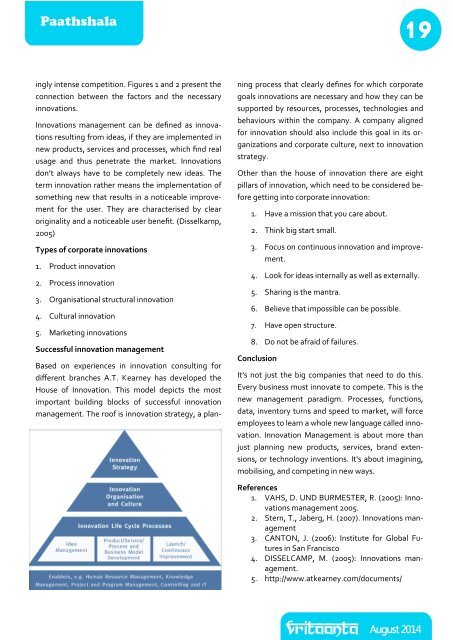Vritaanta August 2014
The monthly magazine of SIBM Pune
The monthly magazine of SIBM Pune
You also want an ePaper? Increase the reach of your titles
YUMPU automatically turns print PDFs into web optimized ePapers that Google loves.
Paathshala<br />
19<br />
ingly intense competition. Figures 1 and 2 present the<br />
connection between the factors and the necessary<br />
innovations.<br />
Innovations management can be defined as innovations<br />
resulting from ideas, if they are implemented in<br />
new products, services and processes, which find real<br />
usage and thus penetrate the market. Innovations<br />
don’t always have to be completely new ideas. The<br />
term innovation rather means the implementation of<br />
something new that results in a noticeable improvement<br />
for the user. They are characterised by clear<br />
originality and a noticeable user benefit. (Disselkamp,<br />
2005)<br />
Types of corporate innovations<br />
1. Product innovation<br />
2. Process innovation<br />
3. Organisational structural innovation<br />
4. Cultural innovation<br />
5. Marketing innovations<br />
Successful innovation management<br />
Based on experiences in innovation consulting for<br />
different branches A.T. Kearney has developed the<br />
House of Innovation. This model depicts the most<br />
important building blocks of successful innovation<br />
management. The roof is innovation strategy, a planning<br />
process that clearly defines for which corporate<br />
goals innovations are necessary and how they can be<br />
supported by resources, processes, technologies and<br />
behaviours within the company. A company aligned<br />
for innovation should also include this goal in its organizations<br />
and corporate culture, next to innovation<br />
strategy.<br />
Other than the house of innovation there are eight<br />
pillars of innovation, which need to be considered before<br />
getting into corporate innovation:<br />
1. Have a mission that you care about.<br />
2. Think big start small.<br />
3. Focus on continuous innovation and improvement.<br />
4. Look for ideas internally as well as externally.<br />
5. Sharing is the mantra.<br />
6. Believe that impossible can be possible.<br />
7. Have open structure.<br />
8. Do not be afraid of failures.<br />
Conclusion<br />
It's not just the big companies that need to do this.<br />
Every business must innovate to compete. This is the<br />
new management paradigm. Processes, functions,<br />
data, inventory turns and speed to market, will force<br />
employees to learn a whole new language called innovation.<br />
Innovation Management is about more than<br />
just planning new products, services, brand extensions,<br />
or technology inventions. It's about imagining,<br />
mobilising, and competing in new ways.<br />
References<br />
1. VAHS, D. UND BURMESTER, R. (2005): Innovations<br />
management 2005.<br />
2. Stern, T., Jaberg, H. (2007). Innovations management<br />
3. CANTON, J. (2006): Institute for Global Futures<br />
in San Francisco<br />
4. DISSELCAMP, M. (2005): Innovations management.<br />
5. http://www.atkearney.com/documents/






